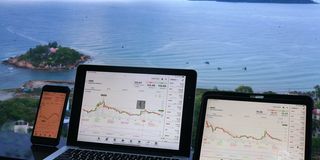Prime
Using leverage to your advantage in trading

In the financial markets, leverage is borrowed money used to increase the buying power of your initial capital. It can be referred to as a loan returned to the broker as the position is closed. Margin can act as a double sword, i.e., awarding you with significant gains or liquidating your portfolio completely.
Previously the concept of leverage was limited to big financial institutions and traders. With the advancements in the fintech sector, it became readily available to small investors. Now traders can access up to 1:3000 leverage on their accounts. Forex trading in Kenya is becoming more popular as more traders use margin to their advantage.
Understanding Leverage
Let us take some examples from currency trading to understand leverage broadly. Suppose you have $10,000 in your trading account. As one lot equals 100000 units of currency, you’ll only be able to open a 0.1 lot position on EURUSD. The profits and the losses will hence be limited to the initial position size and the respective market movement.
To get more profits/risk, you can add leverage if offered by your trading broker. A 1:10 leverage will increase the overall buying power from $10,000 to $100,000. You can now open a one lot position on your account.
Once your equity reaches zero, the broker will remove all the lent capital from the account. This is done to safeguard their own balance.
Understanding Margin
Before we dive into the potential advantages of leverage, it is better to clarify what margin is. Margin is the amount of money you need in your trading account to access leverage from the broker. For example, an account with a $500 balance and leverage of 1:100 has a margin of $500.
Margin is usually expressed in percentages. For example, 0.5%,2%, and 5%.
MARGIN REQUIREMENT | MAXIMUM LEVERAGE |
5.00% | 20:1 |
3.00% | 33:1 |
2.00% | 50:1 |
1.00% | 100:1 |
0.50% | 200:1 |
0.25% | 400:1 |
Table 1. You can observe the maximum leverage and the required margin percentage
Proper Ways to Use Leverage
Properly using the leverage will ensure that you don’t receive any margin calls on the account, which is generally the case with most traders.
Beginners
If you are a beginner starting out in the markets, make sure that you use the minimum amount of leverage. A 1:2 or 1:5 will be enough. You can also use demo accounts to get a broad understanding of the subject.
Most brokers can offer virtual portfolios with up to 1:3000 leverage. Demo accounts do not have real money. Instead, they contain paper money for individuals to grasp the markets better.
Amateurs
As an amateur trader, you can start experiencing various strategies that use high leverage. News trading or scalping is particularly noticeable here as both can offer a good risk: reward ratio with proper risk management and psychology. The value of leverage still shouldn’t exceed 1:25.
Professionals
Professional traders usually trade with a high capital. As your margin increases, the amount of leverage a broker offers can decrease. This is done to prevent significant loss of money.
As pro investors have a good idea of market knowledge, they understand the risks of using high leverage. They keep the value minimal at 1:10.
Safeguarding your capital
The first and foremost rule in trading is to avoid losing money. Even with high leverage, you can still manage your risk by using stop loss and take profits. Do not risk more than 1% of capital on any trade.
Advantages of leverage
As mentioned before, leverage can act as a double sword. Here are some positive aspects of leverage:
The potential profits are increased by a significant margin
For companies obtaining leverage can provide liquidity to their initial capital. The added cash can be used for any desired prupose and grow the company
There is no added fee to use leverage. After your position is closed, the broker removes its cash at no additional costs
During periods of low volatility, leverage can be used to open big positions and get returns from a few trades.
Disadvantages of leverage
Here are some drawbacks that you should note:
Using a high leverage can add significant risk to your account. It increases the chance of receiving a margin call
You may have to pay a higher swap fee on your trades
Leverage trading can be complex for beginners. Using margin without proper risk management and market knowledge can cause an emotional imbalance in their trading
Final thoughts
Leverage increases the buying power of your initial capital in financial trading. It can be advantageous for increasing potential profits, providing liquidity, and opening prominent positions during low volatility. Traders should also note its drawbacks, such as increasing the risk of receiving a margin call, higher swap fees, and being complex for beginners without proper risk management and market knowledge.
It is important to understand the margin and use leverage properly. Safeguarding your capital is crucial. Use stop loss and take profits while not risking more than 1% of capital on any trade can help manage risks.




